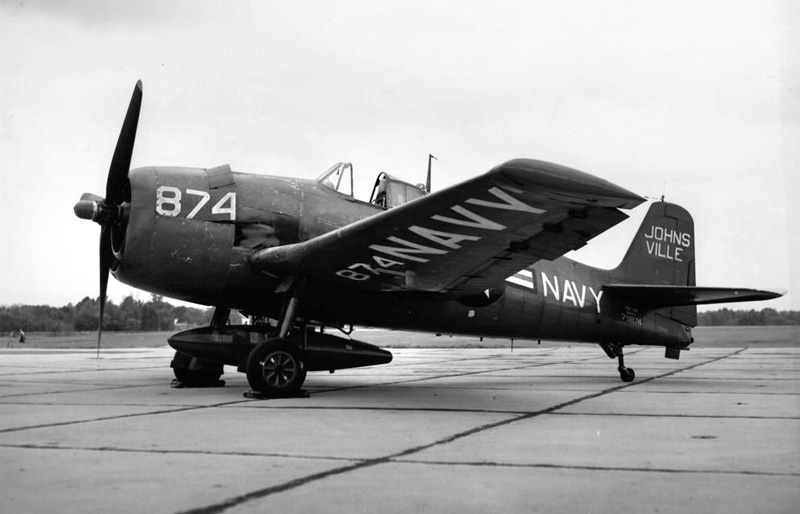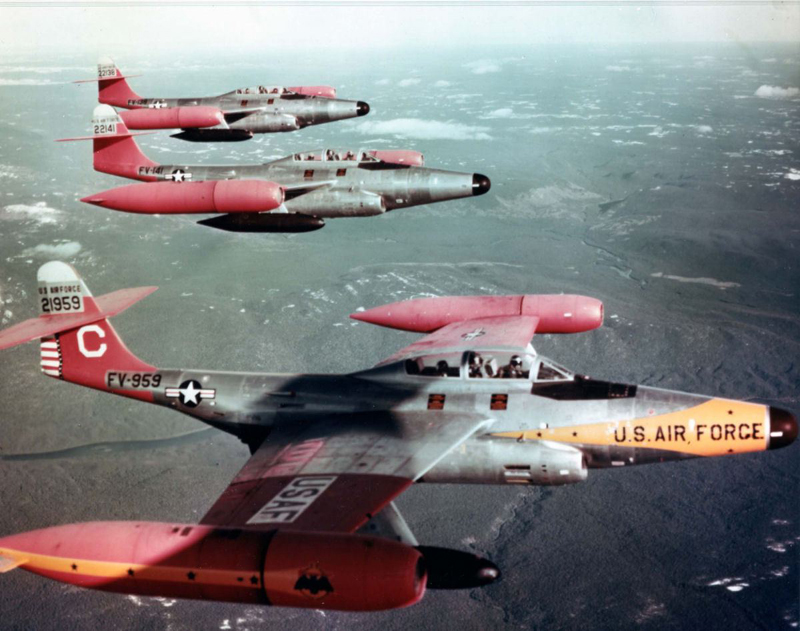|
|
The Battle of Palmdale.
| Heritage Junction Dispatch, January-February 2015.
|
"Residents of the northern area of Los Angeles County found themselves under rocket bombardment yesterday afternoon..." —Los Angeles Times, Aug. 17, 1956 They called it the Battle of Palmdale. It was likely the only military "engagement" ever to take place in the skies over the Santa Clarita Valley. It occurred in the midst of the Cold War.
Drone Gone Wrong
At 11:34 on the morning of Aug. 16, 1956, a radio-controlled drone took off on a routine missile test from the Point Mugu Naval Air Missile Test Center. Described as an obsolete World War II fighter plane built by Grumman Aircraft Engineering Corp., the unmanned F6F-5K Hellcat, on its final mission, was supposed to route seaward to the missile test range off the coast of Point Mugu. The plane would be controlled by ground radios until airborne, when a "mother plane" would take over.
But something went terribly wrong with the mission that day. Instead of heading for the sea, the drone spiraled out of control and headed southeast toward Los Angeles. An immediate alert was sent out by Navy officials, resulting in two Northrop F-89D Scorpion twin-jet interceptors from the 437th Fighter Interceptor Squadron being scrambled on an intercept mission from Oxnard Air Force Base. The two aircraft were piloted by 1st Lts. Hans Einstein of New York and Richard Hurliman of Des Moines, Iowa. In the cockpit with Einstein was radar observer and 1st Lt. C.D. Murray of Miami. Hurliman was accompanied by 1st Lt. Walter Hale, a Texan from Houston. Tagging behind the uncontrolled drone, Einstein and Hurliman crossed over the city of Los Angeles at 30,000 feet from northeast to southwest, then back to the northwest. The goal was to follow the craft to an uninhabited area ... and shoot it down. That "uninhabited" area turned out to be the areas in and surrounding the Santa Clarita Valley. The drone first circled Santa Paula and then headed toward Frazier Mountain. The jet pilots took their first crack at shooting down the wayward aircraft in the mountainous area near Castaic. Even though they fired 208 rockets in three passes, the drone was unscathed. Fortunately it crashed a few minutes later and was destroyed in a field between 110th and 120th Streets East near Avenue P, east of Palmdale.
208 Rockets Overhead
Now scattered throughout the area were the 208 rockets. Thirteen had been found by nightfall and were placed under guard, waiting for a team of demolition experts from Edwards Air Force Base. The next day, the Los Angeles Times reported: "It was believed that many more of the 208 rockets are scattered over the hillsides and canyons of the area, and all persons were warned not to handle them but to call the nearest Air Force or Navy installation immediately."
The Air Force reported that the missiles were designed to arm themselves when fired, but if they missed their target, they were supposed to disarm themselves when they flew below a certain speed. Shrapnel from the missiles was sprayed across parts of the Santa Clarita and Antelope valleys. J.R. Hingle of 4th Street in downtown Palmdale reported his house bombarded by metal, almost hitting Mrs. Lilly Willingham, who was sitting in the house. Mrs. Edna Carlson of 3rd St East in Palmdale saw a chunk of shrapnel go through her front window, bounce off the ceiling, penetrate a wall and end up in a pantry cupboard. Driving west on Palmdale Blvd., Larry Kempton and his mother Bernice were surprised by a rocket that struck the pavement in front of their car. While both escaped injury, the car took direct hits from flying fragments that broke the windshield, tore a hole in the hood, blew out the left front tire and punctured the radiator. Mrs. H.E. Boyes witnessed a rocket sliding across Placerita Canyon several hundred yards south of the Oak of the Golden Dream. "It came out of the sky and hit, then bounced all the way across the canyon. It left a string of fires behind it." After evacuating her daughter, along with her boxer dog Bob and bulldog Susie, Mrs. Boyes returned to the area to help fight the fires. Coworkers J.R. Johns and J.C. Babbit narrowly escaped their demise as they were eating lunch in their work truck, parked in Placerita Canyon. They decided to finish their lunch under a shade tree when moments later, rocket fragments tore through the bed and windshield of their parked truck and completely destroyed it. The fire in Placerita Canyon burned 75 to 100 acres before being brought under control.
Dousing the Flames
As a matter of fact, in spite of all the mayhem over a wide area of Newhall, Saugus and Palmdale, miraculously no one was injured. Other fires started seven miles north of Castaic along the old Ridge Route, and in Soledad Canyon west of Mt. Gleason. The Ridge Route fire was brought under control in the late afternoon after burning 50 to 75 acres. The largest blaze in Soledad Canyon had burned over 300 acres by sundown, requiring an army of 350 men, four tractors, 15 tankers and two helicopters from the Forest Service. The blaze became more complicated when several oil sumps caught fire in the Placerita Canyon oil field. After burning an estimated 350 acres, the Soledad Canyon fire was finally controlled by 3 p.m. the next day. Five hundred fire fighters were ultimately required to bring down the flames. A greater disaster almost occurred when the Placerita fire burned within 100 yards of the Bermite Powder Co. plant. The conflagration was stopped before any fireworks could occur.
Aftermath
Not unexpectedly, there was outrage in Los Angeles County over the incident. Supervisor Roger W. Jessup proposed a resolution urging the "utmost care" by Navy officials in sending the robot planes skyward. By Aug. 21, the Los Angeles Times reported that 175 rockets were still unaccounted for. Air Force officials warned that the rockets were still armed, meaning even a slight jarring could detonate any that had not already exploded on ground impact. The Mighty Mouse rockets were described as being 5 feet long and 2.75 inches in diameter. The cause of the missile mishap may have been a failed ground transmitter or a breakdown in the aircraft receiver. It wasn't until 1997 that Edwards Air Force Base NASA archivist and historian Peter Merlin, along with fellow wreck finder and graphic designer Tony Moore, tracked down the undisturbed remains of the drone, eight miles east of Palmdale. Among the objects found were metal plates with inspection stamps and serial numbers, aircraft rudder trim and fragments from camera pods. Ironically, this unarmed, unmanned and obsolete prop-driven aircraft managed to elude two of the most advanced jet interceptors of their time. Alan Pollack, M.D., is president of the Santa Clarita Valley Historical Society.
|
Missiles Fired at SCV
Drone Relic
Pollack Story 2015
Pageant Story 1957
|
The site owner makes no assertions as to ownership of any original copyrights to digitized images. However, these images are intended for Personal or Research use only. Any other kind of use, including but not limited to commercial or scholarly publication in any medium or format, public exhibition, or use online or in a web site, may be subject to additional restrictions including but not limited to the copyrights held by parties other than the site owner. USERS ARE SOLELY RESPONSIBLE for determining the existence of such rights and for obtaining any permissions and/or paying associated fees necessary for the proposed use.






